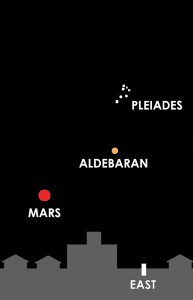ARTS AND CULTURE: Welles’ planet of terror shines brightly on Halloween
Published 12:00 am Saturday, October 29, 2022

- Mars, as photographed by the European Space Agency spacecraft Rosetta during its February 2007 flyby of the planet. (Public domain)
Mars can be found in eastern sky just after nightfall
“At 20 minutes before eight, central time, Professor Farrell of the Mount Jennings Observatory, Chicago, Illinois, reports observing several explosions of incandescent gas, occurring at regular intervals on the planet Mars.”
It was with those words on Oct. 30, 1938 that a radio announcer first informed the public that something unusual was occurring.
Within an hour, an extraterrestrial cylinder would land in Grovers Mill, New Jersey, unleashing the first of many armored alien tripod walkers on the eastern seaboard of the United States and New York City would be vaporized.
Of course, it was all just a radio dramatization of H.G. Wells’ 1898 novel, “The War of the Worlds,” presented by 23-year-old director Orson Welles and The Mercury Theatre on the Air (as intermittent announcements during the broadcast made clear), but that did not stop a portion of the listening audience from panicking and thinking that an actual invasion from Mars was underway.
While the level of hysteria has been exaggerated in some accounts as the broadcast’s legend spread, and the entire country did not descend into chaos, CBS was besieged with calls from a sizable number of frightened listeners.
A young Jack Paar, who would later go onto fame hosting the Tonight Show in the 1960s, was working as an announcer at CBS’s Cleveland affiliate at the time and recalled taking many of these calls.
“The world is not coming to an end,” he recalled telling distraught audience members. “Trust me. When have I ever lied to you?”
Paar said callers then began accusing him of “covering up the truth,” frustrating him to the point that he had to bring in the station’s management to assist him.
Structured as a series of news reports interrupting a mundane broadcast of a ballroom concert, Welles’ production seemed realistic enough to spark the fears of a public already on edge as war seemed imminent in Europe with the rise of Nazi Germany.
And the first disclaimer is believed to have been missed by many listeners, as it was read prior to many tuning into the show, with the Martian landers hitting just as a typical lull occurred in a competing, top-rated program, the Chase and Sanborn Hour (featuring ventriloquist Edgar Bergen and his sidekick, Charlie McCarthy), and many would scan the dial to skip out on the weekly musical number (Whether Welles deliberately timed the most alarming portion of his program for this moment has long been debated).
Days after the noninvasion, the young host appeared before the media and charmed his way through an apology to those who misinterpreted the broadcast, and the hype made him an instant household name. He soon landed a production deal in Hollywood, culminating in the release, three years later, of his directorial masterpiece, Citizen Kane, widely considered the greatest film of all time.

The view of the night sky for this weekend and Monday, looking east, shortly after 9 p.m. NOTE: Fainter stars have been omitted from chart. (The Ironton Tribune illustration)
It is fitting that this weekend, on the eve of Halloween and Sunday’s 84th anniversary of the War of the Worlds broadcast, that Mars, once again, has a place of prominence.
The red planet can easily be spotted in the sky as night falls.
The brightness of the planet in our sky varies throughout the year, depending on its position in its orbit and distance from Earth, but, these next few weeks, it is in a particularly bright phase and hard to miss.
To spot Mars, look to the east, from 9-10 p.m. and, low in the sky, you will see it, brighter than any of the surrounding stars and notable for its distinctive red color.
The fourth planet from the sun, Mars gets its rusty tint from the iron oxide on its surface, so plentiful that it affects the view from Earth tens of millions of miles away.
The red planet rises as the night progresses and can be seen until sunup, when it is high in the night sky. It will continue to brighten in coming weeks, until Dec. 8, when it reaches opposition and the earth is directly between it and the sun.
Mars is currently in the constellation of Taurus, one of the Zodiac, a group of 12 constellations through which the planets move.
Not far above Mars, in Taurus, one can spot the Pleiades, “the seven sisters,” a small cluster of stars that appears at first as a tiny silvery cloud to the naked eye.
Significant to observers since antiquity, the Pleiades were noted by the ancient Greeks and are mentioned in the Bible in the Book of Job.
Between Mars and the Pleiades lies a bright orange-red star, Aldebaran, the brightest in the constellation.
While Aldebaran is one of the brightest stars in the sky, its luminosity seems a bit subdued for now, with Mars close by. But its appearance in early night is a harbinger of the even brighter stars on the way in the winter constellations, which create the holiday skies that are a favorite of astronomers.
In the meantime, as you take the kids trick or treating on Monday, enjoy the view of our neighboring planet, and take comfort that, this year, there are no reports of any landings in New Jersey or elsewhere.
Heath Harrison is The Ironton Tribune’s community editor and has been fascinated by the night sky since reading H.A. Rey’s “Find the Constellations” as a six year old.





